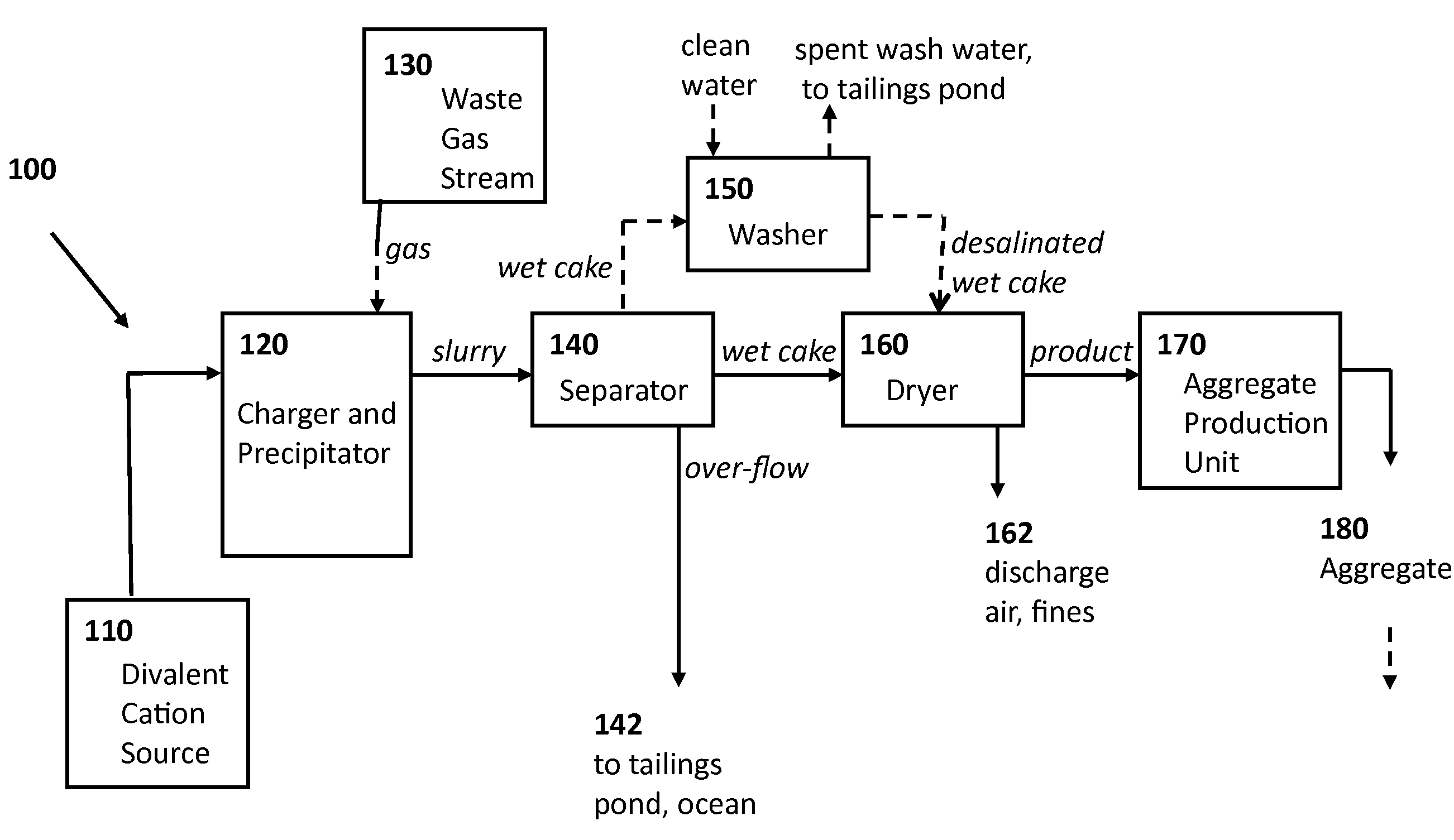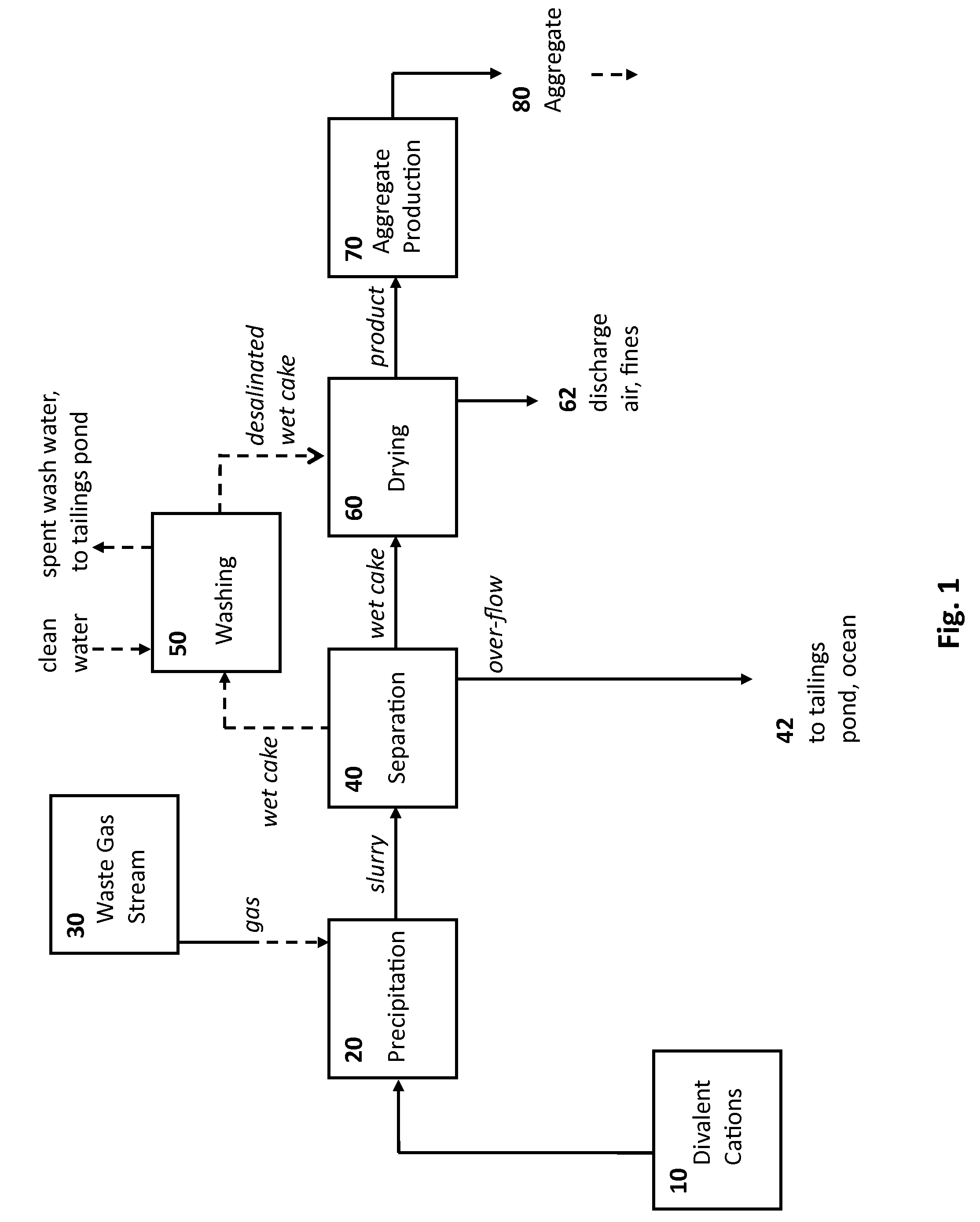Rocks and aggregate, and methods of making and using the same
a technology of aggregate and rock, applied in the field of rock and aggregate, and methods of making and using the same, can solve the problems of economic, environmental, operational, environmental and other problems, and the impact of climate change will likely be economically expensive and environmentally hazardous
- Summary
- Abstract
- Description
- Claims
- Application Information
AI Technical Summary
Benefits of technology
Problems solved by technology
Method used
Image
Examples
example 1
Preparation of Precipitation Material for Use in Aggregate
[0272]76,000 gallons of seawater was pumped at 40 gallons per minute into a 250,000-gallon open tank configured with spargers in the bottom of the tank until the height of seawater in the tank was six feet above the spargers. Carbon dioxide was subsequently sparged into the seawater at a rate that kept the pH above 5.6.
[0273]With continued carbon dioxide sparging, a slurry containing 4,500 kg of jet-milled (to decrease particle size and improve dissolution rates) magnesium hydroxide was added through piping with in-line mixers. (The magnesium hydroxide for this experiment was waste from a seawater magnesia (MgO) plant, the magnesium hydroxide being about 85% Mg(OH)2, about 12% CaCO3, and about 3% SiO2.) Carbon dioxide sparging continued after complete addition of magnesium hydroxide and until 9,400 pounds of carbon dioxide had been added. Half of the reaction mixture in the tank (Tank A) was subsequently transferred to anothe...
example 2
Preparation of Aggregate from Precipitation Material
[0281]The steel molds of a Wabash hydraulic press (Model No.: 75-24-2TRM; ca. 1974) were cleaned and the platens were preheated such that the platen surfaces (including mold cavity and punch) were at 90° C. for a minimum of 1 hour.
[0282]Some of the precipitation material filter cake from Example 1 was oven-dried in sheet pans at 40° C. for 48 hours and subsequently crushed and ground in a blender such that the ground material passed a No. 8 sieve. The ground material was then mixed with water resulting in a mixture that was 90-95% solids with the remainder being the added water (5-10%).
[0283]A 4″×8″ mold in the Wabash press was filled with the wet mixture of ground precipitation material and a pressure of 64 tons (4000 psi) was applied to the precipitation material for about 10 seconds. The pressure was then released and the mold was reopened. Precipitation material that stuck to the sides of the mold was scraped and moved toward t...
example 3
Aggregate from Mixture of Wollastonite and Precipitation Material
[0286]Some of the precipitation material prepared in Example 1 (primarily nesquehonite rods from an unwashed filter cake of precipitation material) was dried in an oven to a consistent weight. The dried starting precipitation material (5 kg) was subsequently added to a reaction vessel followed by 1 kg of commercial grade wollastonite (calcium silicate) and 500 mL of 50% (w / w) sodium hydroxide (with stirring). With continued stirring, 12 kg of water was added to the reaction mixture. The reaction mixture was subsequently heated at 70° C. overnight.
[0287]The resulting product material was filtered, spray dried, and used to prepare aggregate as described in Example 2, including the optional step of drying the aggregate on an drying rack in a 110° C. oven for 16 hours.
[0288]
TABLE 5XRF elemental analysis of wollastonite starting materialNaMgAlSiSClKCaFeWeight0.000.480.2722.120.000.190.0036.180.30%
[0289]
TABLE 6XRF elemental ...
PUM
| Property | Measurement | Unit |
|---|---|---|
| density | aaaaa | aaaaa |
| density | aaaaa | aaaaa |
| bulk density | aaaaa | aaaaa |
Abstract
Description
Claims
Application Information
 Login to View More
Login to View More - R&D
- Intellectual Property
- Life Sciences
- Materials
- Tech Scout
- Unparalleled Data Quality
- Higher Quality Content
- 60% Fewer Hallucinations
Browse by: Latest US Patents, China's latest patents, Technical Efficacy Thesaurus, Application Domain, Technology Topic, Popular Technical Reports.
© 2025 PatSnap. All rights reserved.Legal|Privacy policy|Modern Slavery Act Transparency Statement|Sitemap|About US| Contact US: help@patsnap.com



